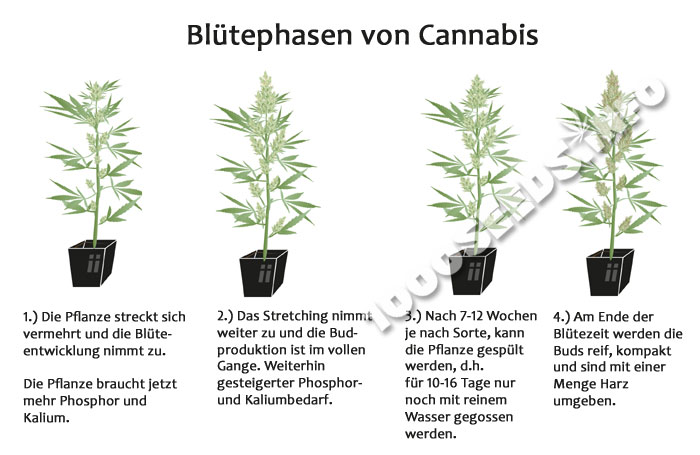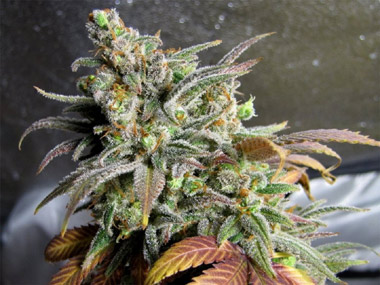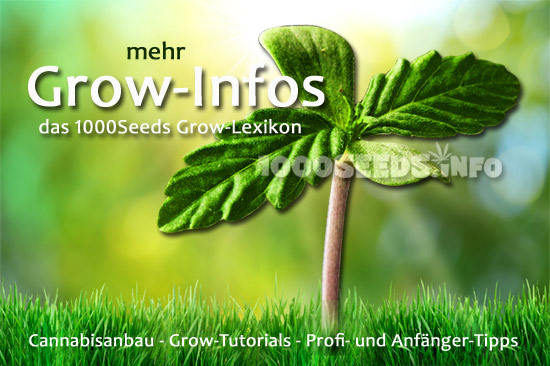Flowering phase / flowering time
The pre-bloom appears towards the end of the growth phase and indicates the sex of the cannabis plant. Beginners and many other growers find it difficult to recognise the gender in the pre-bloom. The males can still be recognised later, when the flowering has been initiated, and then sorted out in time, so don't panic if the pre-bloom doesn't help you.
With the pre-bloom, the plant signals that it is now sexually mature. If it is sent into flowering from this point on, i.e. the daily lighting time is reduced to 12 hours, it will begin to flower. Photoperiod (non-automatic) cannabis plants can be kept in the vegetative phase for a longer period of time, even years, with proper care.
Cannabis gardeners invariably cultivate the female cannabis plants (unless they want to breed) because only female plants get potent buds and produce the coveted weed we value for its effects.
As a rule, experienced indoor growers leave their plants in the growing phase until they have reached a sufficient size, have developed a good root system and are healthy and strong. The longer a cannabis plant is left in the growing phase, the bigger it will grow and the more side branches it will produce. When growing indoors, it makes less sense to grow plants that are too big, as effective lighting is no longer possible with them.
In the wild, cannabis plants grow from April to October/November, depending on the weather region, and start flowering when the days get shorter in autumn. Cannabis plants therefore flower outdoors between the beginning of September and mid/end of November, this depends greatly on the variety grown. Auto-flowering cannabis strains can flower much earlier outdoors and, if you are lucky with the sun, can produce 2 harvests.
The 12/12 cycle
The daily lighting period of 12 hours stimulates the cannabis plant to flower. Throughout the flowering period, the plants need to be lit for 12 hours per day with a sodium vapour lamp, which produces sufficiently strong light for cannabis flowering. You can find out more about lighting cannabis here.
12-hour illumination with a sodium vapour lamp (high-power LED) -> followed by 12 hours of absolute darkness without "light pollution" -> then 12-hour illumination again, etc. until they are ready/mature without interrupting this rhythm.
If the exposure time has been changed, it takes 1-3 weeks until the first flowers are visible. Cannabis flowers get long furry white hairs, which are also called pistils. These stand upwards in a v-shape. The hairs are stuck in a light green calyx, the ovary. The ovaries are clustered on the stems to form buds. The buds form panicles and form close together. The main stem with its huge flower clusters, which many varieties produce, is often called headbud or cola.
If flowering is initiated before a plant has entered pre-bloom, certain problems may occur:
- Problems with gender (hermaphrodite)
- strange bud growth, unusual flowers
During the flowering period, the cannabis plant changes its growth behaviour and the chemical processes within the plant also change. The side branches become longer, fewer leaves develop, the cannabinoid production is briefly reduced until it finally increases enormously. Mostly, there is a rapid flower formation at the beginning, which then slows down again in the further course.
In the first 4-6 weeks of flowering, the ovaries develop rapidly, then there is a slowdown. The real harvest weight is produced only in the last 2-3 weeks of flowering.
The individual phases naturally also bring with them a corresponding change in nutrient requirements. The cannabis fertiliser manufacturers specify in their fertiliser schedules exactly when how much fertiliser should be given in which week. This makes it relatively easy to keep the plants well supplied without over- or under-fertilising. You can read more about this in our articles on how to fertilise cannabis properly.

Flowering plants have less water requirements than plants in the vegetative phase. Cannabis plants need just as much water in the flowering phase so that resin production and chemical processes function well.
During the entire flowering period, enough water must be given, only towards the very end and shortly before harvesting (2-4 days before) do some growers stop giving water in order to increase resin production. However, this measure must not be used earlier, otherwise it will only do harm.
Fertilised fruit nodes stop producing THC and concentrate exclusively on seed production. Therefore, one wants to avoid fertilising female plants at all costs.
Only "sinsemilla", i.e. weed without seeds is potent and works decently as you would imagine. Unfertilised female plants continue to flower throughout the flowering period until resin and THC production peaks 6-12 weeks after light change. The ovaries become steadily thicker and larger during this time. Any female plant can become Sinsemilla, you just have to remove all male plants in time or use feminised seeds.
Learn more about flowering time in cannabis, the right time to harvest, methods to increase yields, troubleshouting at flowering.... in our grow encyclopedia at 1000Seeds.
Flowering phase
- Pre-flowering, initiation of flowering and flowering phases
- Beginning of flowering
- male / female / hermaphrodite
- Hermaphroditism in cannabis plants
- Flower development and maturity
- Tips for increasing resin production
- the most important parameters in cannabis cultivation

Grow requirements for the flowering phase
- Cannabis fertiliser
- Flower booster
- Grow accessories
- Planters
- Grow tents and grow boxes
- Irrigation
- Climate
- Climate control
- Pest control
- Complete sets
- Cannabis lighting







